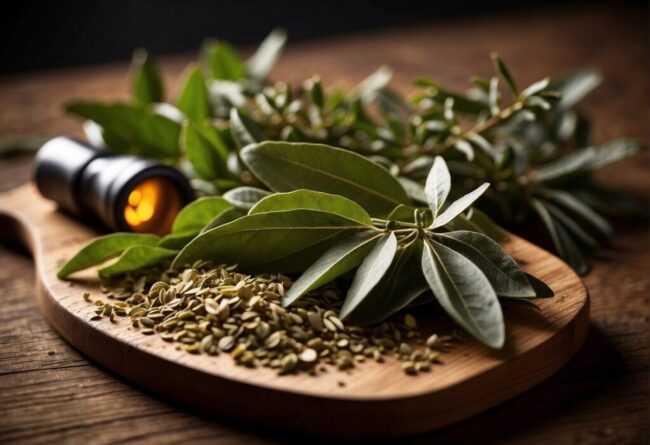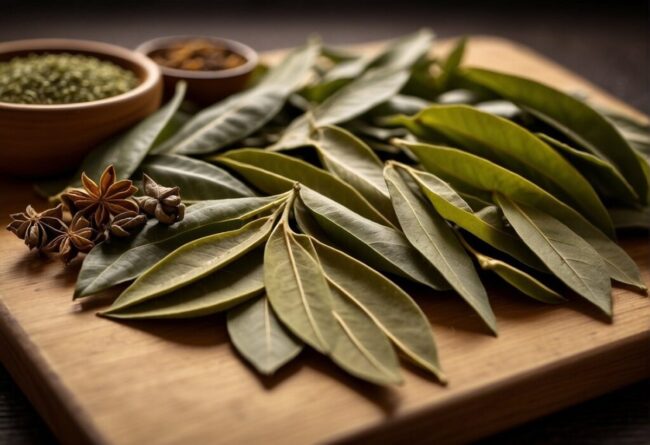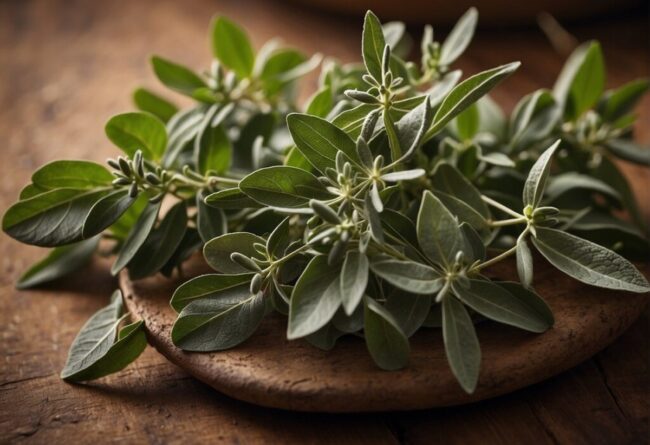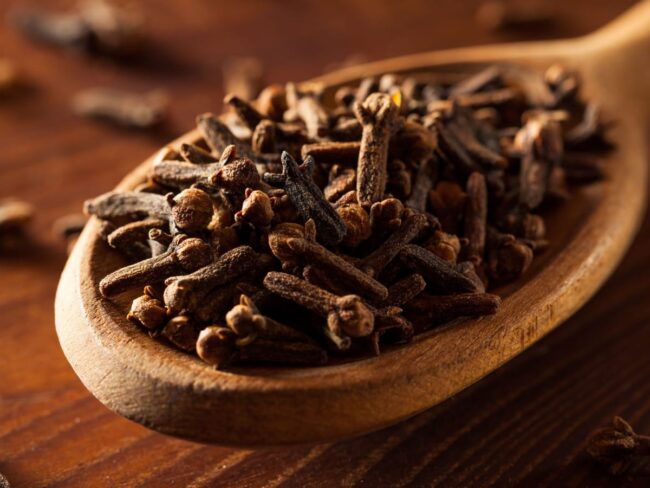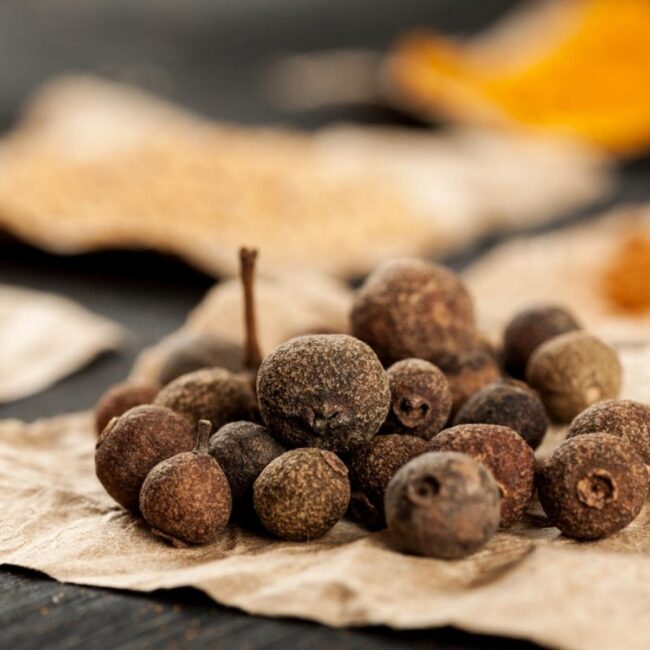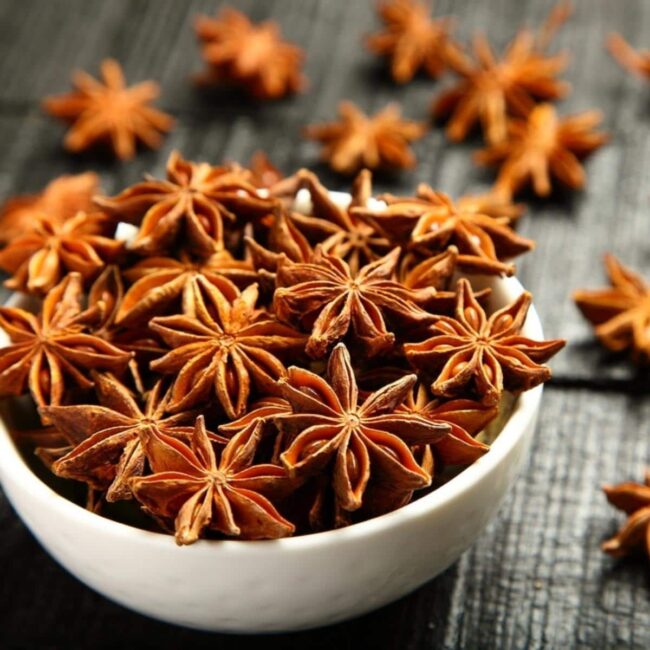16 Substitutes That Work Instead of Bay Leaves
Bay leaves substitutes help maintain depth in soups, stews, and sauces when this aromatic herb isn't on hand.
Some choices mimic the same herbal warmth, while others offer a more subtle or earthy note.
However, choosing the suitable options depends on whether it's used for simmering, seasoning, or infusing flavor.
What Are Bay Leaves?
Bay leaves come from the evergreen laurel tree, known for their essential role in Mediterranean cooking.
Fresh bay leaves shine with a lively green color and have a gentler flavor than dried ones.
Once dried, they take on an earthy tone while their taste becomes stronger and more concentrated.
These leaves blend herbal, floral, and slightly menthol notes with hints of woody flavors that enrich soups, stews, or braises when added whole during cooking.
After simmering to extract their essence, remember to remove them before serving as they are not meant to be eaten directly.
Using bay leaves requires care; starting with just a few can help achieve the desired flavor without overwhelming your dish.
Common Bay Leaf Replacements
Popular bay leaf substitutes bring earthy and aromatic notes to recipes. They work well in soups, stews, and sauces.
Thyme Herb Guide
Thyme adds a rich depth to your cooking, enhancing flavors in various dishes.
This herb offers earthy undertones that can elevate everything from roasted vegetables to savory sauces.
When fresh thyme isn’t available, dried thyme serves as a convenient alternative with an intensified taste profile.
Measuring out just a quarter teaspoon for each bay leaf ensures the right balance without overpowering the dish.
Incorporating this aromatic herb into your meals opens up new dimensions of flavor that are sure to impress anyone at the table.
Oregano Herb
Oregano adds a rich, aromatic flavor that elevates dishes in delightful ways.
Its slightly stronger taste compared to thyme means a little goes a long way, ensuring your meals are well-balanced.
When cooking with oregano, using just a quarter teaspoon of dried herb for each bay leaf helps achieve the perfect blend without overwhelming other flavors.
This herb pairs beautifully with tomatoes and is often found in Mediterranean cuisine, enhancing everything from pasta sauces to grilled meats.
Discovering how oregano can transform simple recipes into savory experiences makes it an essential addition to any kitchen spice rack.
Rosemary Herb Guide
Rosemary offers a bold aroma and a distinctive pine flavor, making it an excellent alternative to bay leaves.
Its unique essence elevates dishes with earthy undertones that can transform simple recipes into flavorful experiences.
A small sprig is all it takes to enhance soups, stews, or roasted vegetables.
This herb pairs well with meats and can even add depth to bread and baked goods.
Discovering how rosemary complements other ingredients opens up new culinary adventures in your kitchen.
Wise Guidance
Sage brings a distinctive, slightly peppery flavor that can effectively replace bay leaves in various dishes.
A little goes a long way; just one small fresh leaf or a pinch of dried sage can mimic the savory essence found in bay leaves.
This herb complements soups and stews beautifully, enhancing the overall taste without overpowering other ingredients.
The aromatic quality of sage adds depth to your culinary creations, inviting you to explore new flavor profiles.
When experimenting with recipes, consider this herb for its unique twist on traditional flavors while keeping things balanced and delicious.
Juniper Berries Explained
Juniper berries add an exciting twist to your cooking with their unique flavor profile.
Their fruity and piney notes shine brightly, especially in hearty stews and rich sauces.
Crushing these little gems releases their aromatic oils, enhancing dishes with a subtle yet distinct taste.
Using juniper berries instead of bay leaves introduces a resinous quality that elevates the overall flavor experience.
Experimenting with this ingredient can transform familiar recipes into something memorable and delightful for your palate.
Bay Leaf Alternatives by Region
Region-specific bay leaf substitutes provide local flavors that enhance traditional recipes. They bring authenticity while maintaining a similar aromatic touch.
Indian Dish Ideas
Turkish bay leaves, or tej patta, add a special touch to Indian cooking.
These leaves bring a unique aroma that enhances the flavors of dishes without overpowering them.
When experimenting in the kitchen, cassia bark or cinnamon serve as excellent substitutes for those elusive bay leaves.
They introduce a warm undertone that complements slow-cooked meals beautifully.
Every dish becomes an opportunity to explore new tastes and elevate your culinary creations with these aromatic ingredients.
Mexican Oregano Herb
Mexican oregano serves as a fantastic substitute for bay leaves in traditional dishes.
This herb carries a vibrant, citrusy flavor that enhances the richness of tomato-based meals and chili recipes.
A little goes a long way, so using it sparingly is wise; its potency can easily overshadow other ingredients.
When cooking chili, try adding just 1/4 teaspoon for every bay leaf required to achieve balance.
For sauces, starting with a pinch allows you to adjust the taste according to your preference while elevating your culinary creations effortlessly.
Tastes of the Caribbean
Caribbean cuisine thrives on vibrant flavors and fragrant ingredients.
When bay leaves are unavailable, allspice steps in beautifully, adding a warm sweetness that enriches your meals.
This spice shines especially in Jamaican and Haitian dishes, where it elevates the aroma of stews and meat preparations.
The complexity of allspice enhances not just the taste but also the overall culinary experience you aim to create.
With each use, this versatile ingredient brings a distinct character to your cooking adventures; it’s worth keeping on hand for any Caribbean-inspired recipe you tackle next.
Herbs That Replace Bay Leaves
Alternative herbs that mimic bay leaves offer fresh ways to enhance flavors. They bring similar depth to dishes without overpowering them.
Fresh Cilantro Herb
Cilantro offers a refreshing burst of flavor that contrasts nicely with the deeper notes of bay leaves.
Its unique taste enhances many dishes, especially in Indian cuisine where it shines brightly.
When bay leaves aren't on hand, cilantro stems provide an aromatic alternative that infuses soups and stews with zest.
This herb can elevate your meals without overwhelming them, showcasing its versatility in various recipes.
Keeping a small bunch handy adds an easy way to experiment with flavors and bring new life to familiar favorites.
Sweet Marjoram Herb
Marjoram offers a gentle sweetness that enhances various dishes.
This herb serves as an excellent substitute for bay leaves, allowing the other ingredients to shine through without overpowering them.
In recipes where bay leaves are typically used, a couple of pinches of dried marjoram can create a delightful shift in flavor.
Its mild profile makes it especially suited for European cuisine, where its nuances can be appreciated fully.
Adding this herb to your pantry introduces new dimensions to your cooking adventures and invites creativity in the kitchen.
Fresh Basil Leaves
Basil is an excellent alternative to bay leaves, showcasing a sweet and slightly peppery flavor that can elevate your dishes.
This herb finds its place in both Mediterranean and American cuisines, adding a gentle essence that enhances many recipes.
When substituting, just a 1/4 teaspoon of dried basil will suffice for each bay leaf needed in your dish.
Its versatility makes it easy to incorporate into sauces, stews, or marinades without overpowering the other ingredients.
Keep some on hand for those moments when you want to infuse your cooking with fresh taste even when fresh herbs aren’t available!
Boldo Plant Leaf
Boldo leaves add an intriguing twist to your culinary adventures.
Their slightly bitter profile offers a unique flavor that sets them apart from traditional bay leaves.
Cooking with boldo can enhance Latin American dishes, giving them a distinctive character that might surprise you.
A little goes a long way, so experimenting with small quantities helps find the right balance for your palate.
Discovering this underappreciated herb could lead to exciting new recipes and flavors in your kitchen!
Spices That Replace Bay Leaves
Using spices as bay leaf alternatives adds warmth and complexity to meals. These options work well in both savory and aromatic dishes.
Clove Spice Guide
Clove adds a bold, aromatic flair to various dishes.
Its unique flavor profile combines a pungent essence with a hint of sweetness that can elevate your meals.
Just a small amount goes a long way, making it an economical choice for seasoning.
When cooking, one clove provides the depth often sought from multiple bay leaves without overpowering other ingredients.
Experimenting with this spice can lead to exciting culinary discoveries and unforgettable flavors in everyday recipes.
Cinnamon Spice
Cinnamon introduces a unique warmth to dishes, offering a fragrant alternative to bay leaves.
A small stick can enhance the subtlety of flavors in soups and stews, allowing it to blend seamlessly into the mix.
This spice works wonders during long cooking times, where its essence can deeply infuse the ingredients.
Think about how its aromatic profile complements savory elements while adding an unexpected twist.
Next time you’re in need of bay leaf, reach for cinnamon instead; it could surprise you with its delightful contribution to your culinary creations.
Spice Blend Overview
Ground allspice serves as a remarkable alternative in the kitchen, combining the warm essence of nutmeg, cinnamon, and clove.
When used thoughtfully, just a small amount can elevate your dishes with an intriguing depth.
This spice transforms ordinary recipes into something memorable without overwhelming them.
A single pinch can replace one bay leaf effortlessly while introducing a subtle peppery note that dances on the palate.
The versatility of ground allspice encourages culinary exploration and experimentation in any cooking adventure you embark upon.
Sweet Spice Herb
Anise offers a distinctive sweet and licorice-like taste that adds a floral aroma to dishes.
This spice can effortlessly mimic the subtle undertones of bay leaves in various recipes.
A star anise pod or just a pinch of ground anise serves as an excellent alternative when you're out of bay leaves.
Its flavor pairs beautifully with savory meals, enhancing soups and stews alike.
Exploring new flavors can elevate your cooking game, so why not give it a try?
Choosing the Right Bay Leaf Substitute
Finding a suitable substitute for bay leaves can be essential when they are missing from your spice drawer.
These leaves offer a subtle, complex flavor with hints of pepper and menthol that can be tricky to imitate.
Mexican oregano serves as a milder option, featuring delicate anise notes and citrus hints; use half a teaspoon per bay leaf.
Dried thyme provides sharpness similar to bay leaves and works well in equal amounts for added warmth.
For Italian dishes, basil’s sweet yet slightly minty flavor makes it an excellent replacement too.
Juniper berries carry a pine-like essence; crush one or two for effective seasoning without overpowering your dish.
Boldo leaves offer another alternative but should be used sparingly due to their stronger taste profile.
Fresh vs. Dried Bay Leaves
Using bay leaves in cooking can add wonderful flavor, but knowing the difference between fresh and dried forms is important.
Dried bay leaves offer a stronger taste with a sharper, almost medicinal quality due to their concentrated oils.
Fresh ones bring a lively aroma and subtle floral notes but are less common in stores and usually used whole.
When substituting, remember that two dried leaves equal one fresh leaf; however, overcooking dried varieties may create bitterness.
For ground bay leaves, 1/4 teaspoon can replace one fresh leaf effectively.
Always take out whole bay leaves before serving since they pose a choking risk; either type enhances dishes beautifully with their unique flavors.

